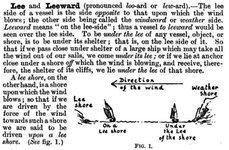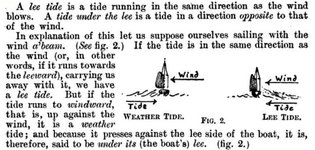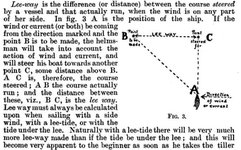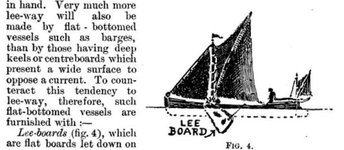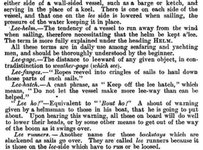Ένας όρος που φαίνεται να προκάλεσε γερό μπέρδεμα στη μετάφραση του Μόμπι Ντικ (αλλά όχι μόνο) είναι το lee coast. Γράφει στο 8ο κεφάλαιο, περιγράφοντας το εκκλησάκι των φαλαινοθηρών.
Between the marble cenotaphs on either hand of the pulpit, the wall which formed its back was adorned with a large painting representing a gallant ship beating against a terrible storm off a lee coast of black rocks and snowy breakers.
«…παρίστανε ένα ηρωικό / γενναίο / περήφανο καράβι να παραδέρνει μέσα σε μια τρομερή καταιγίδα έξω από μια ανεμοδαρμένη ακτή όλο μαύρα βράχια και αφρισμένα κύματα» (δική μου απόδοση).
Λέει και μια γαλλική μετάφραση που τσίμπησα εδώ
«représentant un vaillant navire luttant contre une effroyable tempête au large d’une côte sous le vent dont les rochers noirs étaient enneigés par les brisants».
Πιάνω το νήμα από αλλού, από το weather side των πλοίων, που είναι η προσήνεμη πλευρά των πλοίων, η πλευρά που είναι στραμμένη στον άνεμο, που τη βαράει ο άνεμος, που είναι από τη μεριά του καιρού.
Η αντίθετη πλευρά είναι η υπήνεμη (ή απάνεμη) πλευρά, στα αγγλικά lee side (όπου lee = προστασία, καταφύγιο).
1769 Falconer Dict. Marine (1780) Weather, When a ship under sail presents either of her sides to the wind, it is then called the weather-side.
Έτσι, τα καράβια έχουν αριστερή και δεξιά πλευρά (port side και starboard side), που είναι σταθερές, και lee side και weather side, υπήνεμη και προσήνεμη, που είναι μεταβλητές ανάλογα με τη θέση του πλοίου σε σχέση με τον άνεμο, τον καιρό.
1883 Man. Seamanship for Boys 3 Salutes on Board Ship. The starboard side in harbour, and the weather side at sea, is the officers' side.
Όταν όμως οι ναυτικοί που είναι πάνω σε πλοίο κοιτάζουν προς τη στεριά, η ακτή που βλέπουν από τη δική τους υπήνεμη πλευρά του πλοίου ονομάζεται lee shore, αλλά δεν είναι καθόλου υπήνεμη, το αντίθετο. Είναι η πλευρά της ακτής που δέρνει ο άνεμος.
Εύκολα μπορεί να την πατήσει ο μεταφραστής που θα κοιτάξει μόνο το lee στο λεξικό. Μάλιστα, τα λεξικά δεν έχουν το lee coast, αλλά το lee shore. Στο Penguin-Hellenews, πάντως, είναι αμέσως μετά το lee, δεν γίνεται να σου ξεφύγει: «lee shore ακτή πληττομένη υπό του ανέμου (ήτοι προς την υπήνεμον πλευρά πλοίου)» και στο GWord λέει: «ακτή που τη χτυπάει ο άνεμος».
Αναλυτικότατη είναι η εξήγηση στη Wikipedia:
Between the marble cenotaphs on either hand of the pulpit, the wall which formed its back was adorned with a large painting representing a gallant ship beating against a terrible storm off a lee coast of black rocks and snowy breakers.
«…παρίστανε ένα ηρωικό / γενναίο / περήφανο καράβι να παραδέρνει μέσα σε μια τρομερή καταιγίδα έξω από μια ανεμοδαρμένη ακτή όλο μαύρα βράχια και αφρισμένα κύματα» (δική μου απόδοση).
Λέει και μια γαλλική μετάφραση που τσίμπησα εδώ
«représentant un vaillant navire luttant contre une effroyable tempête au large d’une côte sous le vent dont les rochers noirs étaient enneigés par les brisants».
Πιάνω το νήμα από αλλού, από το weather side των πλοίων, που είναι η προσήνεμη πλευρά των πλοίων, η πλευρά που είναι στραμμένη στον άνεμο, που τη βαράει ο άνεμος, που είναι από τη μεριά του καιρού.
Η αντίθετη πλευρά είναι η υπήνεμη (ή απάνεμη) πλευρά, στα αγγλικά lee side (όπου lee = προστασία, καταφύγιο).
1769 Falconer Dict. Marine (1780) Weather, When a ship under sail presents either of her sides to the wind, it is then called the weather-side.
Έτσι, τα καράβια έχουν αριστερή και δεξιά πλευρά (port side και starboard side), που είναι σταθερές, και lee side και weather side, υπήνεμη και προσήνεμη, που είναι μεταβλητές ανάλογα με τη θέση του πλοίου σε σχέση με τον άνεμο, τον καιρό.
1883 Man. Seamanship for Boys 3 Salutes on Board Ship. The starboard side in harbour, and the weather side at sea, is the officers' side.
Όταν όμως οι ναυτικοί που είναι πάνω σε πλοίο κοιτάζουν προς τη στεριά, η ακτή που βλέπουν από τη δική τους υπήνεμη πλευρά του πλοίου ονομάζεται lee shore, αλλά δεν είναι καθόλου υπήνεμη, το αντίθετο. Είναι η πλευρά της ακτής που δέρνει ο άνεμος.
Εύκολα μπορεί να την πατήσει ο μεταφραστής που θα κοιτάξει μόνο το lee στο λεξικό. Μάλιστα, τα λεξικά δεν έχουν το lee coast, αλλά το lee shore. Στο Penguin-Hellenews, πάντως, είναι αμέσως μετά το lee, δεν γίνεται να σου ξεφύγει: «lee shore ακτή πληττομένη υπό του ανέμου (ήτοι προς την υπήνεμον πλευρά πλοίου)» και στο GWord λέει: «ακτή που τη χτυπάει ο άνεμος».
Αναλυτικότατη είναι η εξήγηση στη Wikipedia:
The terms lee shore and windweather or ward shore are nautical terms used to describe a stretch of shoreline. A lee shore is one that is to the lee side of a vessel — meaning the wind is blowing towards it. A weather shore has the wind blowing from inland over it out to sea. For example, if you were standing on a beach, looking out to sea with the wind at your back, you are standing on a weather shore. If the wind is blowing at you, you are on a lee shore.

The "lee" of a boat is the side that the wind touches last as it crosses the boat; in the diagram it is left or port side of the boat. The boat in the diagram has a lee shore to its west. In the diagram, the other side of the island, to the far west, has a weather shore. The wind blows over the shore as it heads to sea. This wind, because it blows from east to west, is called an "easterly" wind. This is because the source of a wind is more ascertainable or knowable than its destination, so winds are named for their source.
This is very confusing for landsmen, as the "leeward side" of the boat, and the "lee shore" of the land face opposite directions, as the diagram shows. "Lee" historically means "shelter", but appears to have shifted, in the sole case of shorelines, to describe the shore exposed to the wind. This would make perfect sense to the sailor, standing on the leeward side of his ship, watching it being pushed towards an exposed shoreline by the wind.
A weather shore is potentially treacherous for kitesurfers and windsurfers, who can be blown out to sea if the wind is blowing from the land. For them, a lee shore is safer. For ocean going vessels during a storm, a lee shore is treacherous because it slowly forces the boat toward the shore, where it will beach or break up. For this reason Bernard Moitessier, the great ocean sailor, called the coastline "the great whore"; it attracts sailors during a storm but is in fact highly dangerous.

The "lee" of a boat is the side that the wind touches last as it crosses the boat; in the diagram it is left or port side of the boat. The boat in the diagram has a lee shore to its west. In the diagram, the other side of the island, to the far west, has a weather shore. The wind blows over the shore as it heads to sea. This wind, because it blows from east to west, is called an "easterly" wind. This is because the source of a wind is more ascertainable or knowable than its destination, so winds are named for their source.
This is very confusing for landsmen, as the "leeward side" of the boat, and the "lee shore" of the land face opposite directions, as the diagram shows. "Lee" historically means "shelter", but appears to have shifted, in the sole case of shorelines, to describe the shore exposed to the wind. This would make perfect sense to the sailor, standing on the leeward side of his ship, watching it being pushed towards an exposed shoreline by the wind.
A weather shore is potentially treacherous for kitesurfers and windsurfers, who can be blown out to sea if the wind is blowing from the land. For them, a lee shore is safer. For ocean going vessels during a storm, a lee shore is treacherous because it slowly forces the boat toward the shore, where it will beach or break up. For this reason Bernard Moitessier, the great ocean sailor, called the coastline "the great whore"; it attracts sailors during a storm but is in fact highly dangerous.


